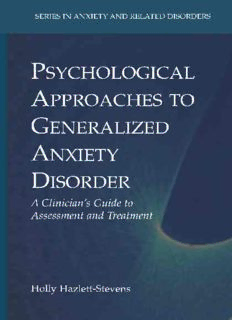
Psychological Approaches to Generalized Anxiety Disorder: A Clinician's Guide to Assessment and Treatment PDF
Preview Psychological Approaches to Generalized Anxiety Disorder: A Clinician's Guide to Assessment and Treatment
Psychological Approaches to Generalized Anxiety Disorder SERIES IN ANXIETY AND RELATED DISORDERS Series Editor: Martin M. Antony, Professor, Department of Psychology, Ryerson University, Toronto, Ontario, Canada ACCEPTANCE AND MINDFULNESS-BASED APPROACHES TO ANXIETY Conceptualization and Treatment Edited by Susan M. Orsillo and Lizabeth Roemer CONCEPTS AND CONTROVERSIES IN OBSESSIVE-COMPULSIVE DISORDER Edited by Jonathan S. Abramowitz and Arthur C. Houts SOCIAL ANXIETY AND SOCIAL PHOBIA IN YOUTH Characteristics, Assessment, and Psychological Treatment Christopher A. Kearney TREATING HEALTH ANXIETY AND FEAR OF DEATH A Practitioner’s Guide Patricia Furer, John R. Walker, and Murray B. Stein TREATING TRICHOTILLOMANIA Cognitive-Behavioral Therapy for Hairpulling and Related Problems Martin E. Franklin and David F. Tolin ANXIETY IN HEALTH BEHAVIORS AND PHYSICAL ILLNESS Edited by Michael J. Zvolensky and Jasper A. J. Smits ANXIETY AND SUBSTANCE USE DISORDERS The Vicious Cycle of Comorbidity Edited by Sherry H. Stewart and Patricia J. Conrod PSYCHOLOGICAL APPROACHES TO GENERALIZED ANXIETY DISORDER A Clinician’s Guide to Assessment and Treatment Holly Hazlett-Stevens A Continuation Order Plan is available for this series. A continuation order will bring delivery of each new volume immediately upon publication. Volumes are billed only upon actual shipment. For further information please contact the publisher. Psychological Approaches to Generalized Anxiety Disorder A Clinician’s Guide to Assessment and Treatment Holly Hazlett-Stevens, Ph.D. University of Nevada, Reno Holly Hazlett-Stevens, Ph.D. University of Nevada, Reno Department of Psychology/298 Reno, NV 89557 USA [email protected] ISBN: 978-0-387-76869-4 e-ISBN: 978-0-387-76870-0 DOI: 10.1007/978-0-387-76870-0 Library of Congress Control Number: 2008928768 © 2008 Springer Science + Business Media, LLC All rights reserved. This work may not be translated or copied in whole or in part without the written permission of the publisher (Humana Press, Springer Science + Business Media, LLC, 233 Spring Street, New York, NY 10013, USA), except for brief excerpts in connection with reviews or scholarly analysis. Use in connection with any form of information storage and retrieval, electronic adaptation, computer software, or by similar or dissimilar methodology now known or hereafter developed is forbidden. The use in this publication of trade names, trademarks, service marks, and similar terms, even if they are not identified as such, is not to be taken as an expression of opinion as to whether or not they are subject to proprietary rights. Printed on acid-free paper 9 8 7 6 5 4 3 2 1 springer.com To Chris and Jack Acknowledgments The ideas and clinical practices contained in this book are based on the innovative work of many researchers and colleagues in the field. I have had the great fortune of working with two exceptional mentors, Tom Borkovec and Michelle Craske, both of whom have influenced my thinking on this topic immeasurably. This book certainly would not have been possible without their teachings and support throughout my career, not to mention their brilliant contributions to our field. The cognitive- behavioral therapy techniques described in this book are based largely on the work of Tom Borkovec, who has been developing and refining GAD treatment approaches for most of his career. In collaboration with Douglas Bernstein, he developed a systematic progressive relaxation method widely recognized for its effectiveness. His more recent work with colleagues Louis Castonguay and Michelle Newman led to the integration of interpersonal and experiential therapy approaches. I consider myself incredibly fortunate to have worked with this group at Penn State, and I am greatly indebted to Tom and his collaborators as well as to Michelle Craske and the many other psychologists involved in my training over the years. My thinking also continues to be enhanced by the bright and creative graduate students in my laboratory: Michael Ritter, Amanda Drews, Deacon Shoenberger, Stephanie Spear, Larry Pruitt, Angie Collins, Kirsten Lowry, and Susan Daflos. I would also like to thank Martin Antony for inviting me to write this book for his anxiety series as well as Sharon Panulla and Jennifer Hadley at Springer for all of their assistance in the preparation of this manuscript. Finally, a special thanks to Larry Pruitt for his essential contributions to the second chapter and to Susan Daflos for all of her wonderful help preparing the final manuscript for production. vii About the Author Holly Hazlett-Stevens received her Ph.D. in clinical psychology from the Pennsylvania State University in 1999. Under the mentorship of Dr. Thomas Borkovec, she studied the nature of anxiety and worry as well as cognitive behav- ioral therapy for generalized anxiety disorder (GAD). From 1999–2001, Dr. Hazlett-Stevens was a post-doctoral fellow in the Department of Psychology at the University of California, Los Angeles under the mentorship of Dr. Michelle Craske. There she received training in cognitive behavioral treatment for panic disorder, coordinated panic disorder intervention research projects, and continued her own program of anxiety and worry research. In 2002, Dr. Hazlett-Stevens joined the faculty of the Psychology Department at the University of Nevada, Reno, where she is currently an Associate Professor. She has conducted psychological research in the areas of worry, anxiety disorders, and relaxation for the past 10 years, resulting in the publication of over 20 articles and book chapters. She also co-authored New Directions in Progressive Relaxation Training with Douglas A. Bernstein and Thomas D. Borkovec. Her self-help book, Women Who Worry Too Much: How to Stop Worry & Anxiety from Ruining Relationships, Work, & Fun was released by New Harbinger publications in 2005. Dr. Hazlett-Stevens has served as an ad-hoc reviewer for several academic and profes- sional journals in the area of clinical psychology, and she has been listed in several Who’s Who lists. ix
Description: